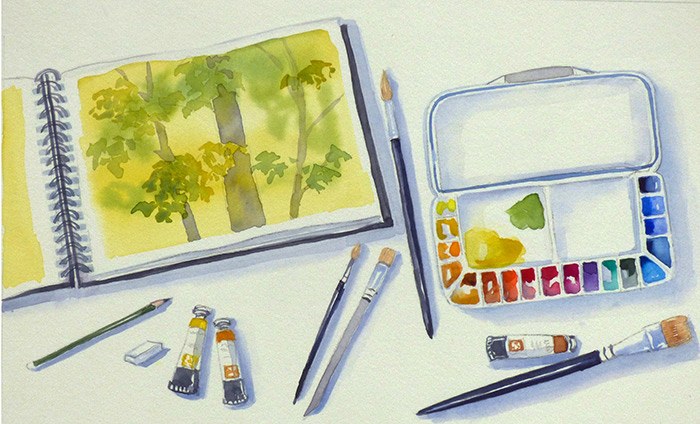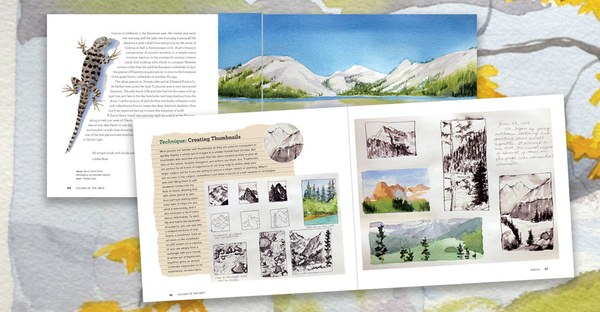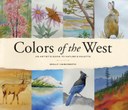
Watercolor is the most quickly executed painting medium and has been used for centuries because of its ease and speed of use and also for the effects than can be achieved with it.
No other medium offers the same possibility to so easily try out ideas and sample colors. More than that, watercolor is inexpensive and easy to set up. I think of it as very democratic! It doesn’t have to be done in a studio and you don’t even need an easel; a camp chair, a boulder, or a kitchen table make fine work spaces, and major technical training is not a prerequisite.
You can make a quick pencil sketch, wet a sheet of watercolor paper, mix up all the colors you see in a landscape, and fill in the sketch in five or ten minutes. Edges won’t be defined if you are using a wet-into-wet method, but the colors will be accurate because you are doing this outdoors, recording what you see in front of you.
Essential Supplies
You don’t really need that many supplies to begin and once you have the basics covered they will last for many months, even years for some pigments you may not use as often.
- A sketchbook is the foundational item. I love 10" x 13" hardcover, spiral-bound sketchbooks, which allow for every type of work and can be opened out in the field with no support other than your lap. The spiral binding allows you to do plein air drawing and painting on one page or on two facing pages for large, panoramic landscapes. I also appreciate the fact that I use only one size and type of sketchbook so there is a semblance of structure in my life and in my studio. I label them so I know where to find sketches, and they sit on a shelf together in chronological order, giving me a sense of accomplishment (however illusory!). Look for sketchbooks with 100 percent rag, 140 lb. cold press watercolor paper. I recommend rag paper because it is made of linen fibers, and is sized, which means it has been dipped twice in an animal by-product, a rich glaze that makes the paper stay wet longer and allows washes to literally slide on. Just compare how color glows on rag paper to how dull it looks on a non-sized wood pulp or cellulose paper and you will discover what I mean. On 100 percent rag paper, you can easily wipe out mistakes, although as pointed out above, some paints are staining and don’t wipe out quite as easily. Cold press, with a very slight texture, yields smoother washes, while hot press, with its satin finish is very good for pen and wash work but is more difficult for larger landscape watercolors. This rag paper is also sold in 22" x 30" sheets and in blocks -- 7" x 10" or 9" x 12" are good sizes and horizontal or square format blocks are interesting as well. You can also cut the large sheets of paper to your preferred dimensions and take it to a copy center to have it spiral bound for a very low cost. Beginners may find that smaller sketchbooks and paper sizes are more ideal.
- HB drawing pencil for light outlines and quick sketches (underdrawings for watercolors). Pencils range in darkness from 6B—too dark for sketching—to 6H—too light for sketching. The HB is the middle range, dark enough to see, but not so dark that it won’t erase cleanly.

- A selection of drawing pens, with fine to medium point nibs, either permanent or water-soluble, available in felt-tip or ball-point style. I almost always do a quick under-drawing in pencil before beginning a watercolor, mainly outlining the perimeter of major shapes—no shading necessary. But it can be a great exercise to challenge yourself to draw with pen, allowing for no erasure—it forces you to look so much more carefully!
- Plastic eraser. White plastic erasers stay clean and crisp—colored erasers, like the pink ones found on #2 classroom pencils, and kneaded erasers retain the erased graphite more and can transfer smudges to your paper when you erase.
- Paper towels or rags for wiping out mistakes, softening edges, blotting excess water from brushes.
- Water and water containers. Small yogurt containers fit perfectly into the cup-holders of a camp chair.
- A portable, lightweight chair, for longer periods of painting, plus a small table or camp stool on which to place your palette, water, and brushes (some chairs come with fold-out tables), or a sit pad or something comfortable to put on the ground. If you prefer to stand, an easel also works.
- Old, plastic water bottle for safely discarding dirty paint water.
- Drafting tape will not tear most watercolor papers.
- A masking fluid pen is an optional item that can be useful for preserving areas of white beneath larger washes. It behaves something like rubber cement. Apply it first, before wetting the paper, and once the masking fluid has dried, you can start painting. Then when the paint is dry, remove the mask with your eraser, or balled-up masking tape.
- A lightweight, plastic palette with a lid and a waterproof seal loaded with the list of paints in the suggested palette above. It’s best to squeeze the paints into the plastic palette and leave the lid open a few days before heading out so they get a chance to dry. I squeeze a small portion of paint—a half-teaspoon—from the tube onto the raised side of each of the palette’s slanted wells. The paint dries there, and when I’m ready to use them, I dab the paints with water and let the wash of color slide down into the bottom of the well.
BRUSHES
- #4 and #6 round sable watercolor brushes. Sable is made from the tail hairs of a member of the weasel family, found in northern Asia. It is soft and flexible and holds a surprising amount of water. Other sizes and types are optional.
- 3/4" flat synthetic brush. Synthetics emulate the natural hairs of the sable but are quite a bit less expensive. Synthetics are fine for #4 and smaller sizes and in general, sable/synthetic blend brushes work well and are cheaper, but in larger round sizes can be a bit too stiff to lay smooth washes. Other brushes I like using are smaller flat synthetic brushes with chisel edges (which are useful for softening edges and lifting out), and riggers or liners for small line work.
- Waterbrushes. If you are hiking and need to limit weight, these can be handy, instead of bulky water containers and brush holders. These plastic brushes have reservoirs that can be filled with water or ink. Choose a small and medium round tip and one large flat.
* * * *
Molly's book, Colors of the West: An Artist's Guide to Nature's Palette, is published by Mountaineers Books and teaches the techniques and color palette you'll need to get started adding this hobby to your outdoor adventures.
 Molly Hashimoto
Molly Hashimoto

